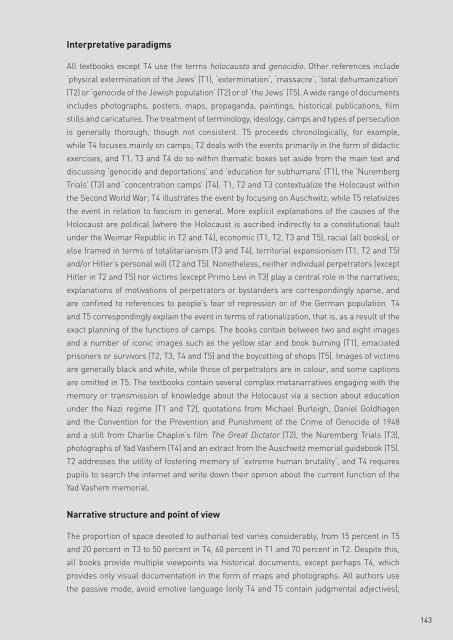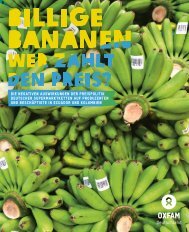228776e
228776e
228776e
Create successful ePaper yourself
Turn your PDF publications into a flip-book with our unique Google optimized e-Paper software.
Interpretative paradigms<br />
All textbooks except T4 use the terms holocausto and genocidio. Other references include<br />
‘physical extermination of the Jews’ (T1), ‘extermination’, ‘massacre’, ‘total dehumanization’<br />
(T2) or ‘genocide of the Jewish population’ (T2) or of ‘the Jews’ (T5). A wide range of documents<br />
includes photographs, posters, maps, propaganda, paintings, historical publications, film<br />
stills and caricatures. The treatment of terminology, ideology, camps and types of persecution<br />
is generally thorough, though not consistent. T5 proceeds chronologically, for example,<br />
while T4 focuses mainly on camps; T2 deals with the events primarily in the form of didactic<br />
exercises, and T1, T3 and T4 do so within thematic boxes set aside from the main text and<br />
discussing ‘genocide and deportations’ and ‘education for subhumans’ (T1), the ‘Nuremberg<br />
Trials’ (T3) and ‘concentration camps’ (T4). T1, T2 and T3 contextualize the Holocaust within<br />
the Second World War; T4 illustrates the event by focusing on Auschwitz, while T5 relativizes<br />
the event in relation to fascism in general. More explicit explanations of the causes of the<br />
Holocaust are political (where the Holocaust is ascribed indirectly to a constitutional fault<br />
under the Weimar Republic in T2 and T4), economic (T1, T2, T3 and T5), racial (all books), or<br />
else framed in terms of totalitarianism (T3 and T4), territorial expansionism (T1, T2 and T5)<br />
and/or Hitler’s personal will (T2 and T5). Nonetheless, neither individual perpetrators (except<br />
Hitler in T2 and T5) nor victims (except Primo Levi in T3) play a central role in the narratives;<br />
explanations of motivations of perpetrators or bystanders are correspondingly sparse, and<br />
are confined to references to people’s fear of repression or of the German population. T4<br />
and T5 correspondingly explain the event in terms of rationalization, that is, as a result of the<br />
exact planning of the functions of camps. The books contain between two and eight images<br />
and a number of iconic images such as the yellow star and book burning (T1), emaciated<br />
prisoners or survivors (T2, T3, T4 and T5) and the boycotting of shops (T5). Images of victims<br />
are generally black and white, while those of perpetrators are in colour, and some captions<br />
are omitted in T5. The textbooks contain several complex metanarratives engaging with the<br />
memory or transmission of knowledge about the Holocaust via a section about education<br />
under the Nazi regime (T1 and T2), quotations from Michael Burleigh, Daniel Goldhagen<br />
and the Convention for the Prevention and Punishment of the Crime of Genocide of 1948<br />
and a still from Charlie Chaplin’s film The Great Dictator (T2), the Nuremberg Trials (T3),<br />
photographs of Yad Vashem (T4) and an extract from the Auschwitz memorial guidebook (T5).<br />
T2 addresses the utility of fostering memory of ‘extreme human brutality’, and T4 requires<br />
pupils to search the internet and write down their opinion about the current function of the<br />
Yad Vashem memorial.<br />
Narrative structure and point of view<br />
The proportion of space devoted to authorial text varies considerably, from 15 percent in T5<br />
and 20 percent in T3 to 50 percent in T4, 60 percent in T1 and 70 percent in T2. Despite this,<br />
all books provide multiple viewpoints via historical documents, except perhaps T4, which<br />
provides only visual documentation in the form of maps and photographs. All authors use<br />
the passive mode, avoid emotive language (only T4 and T5 contain judgmental adjectives),<br />
143




